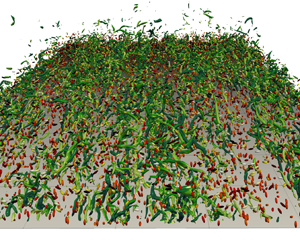Article contents
Translational and angular velocities statistics of inertial prolate ellipsoids in a turbulent channel flow up to Reτ = 1000
Published online by Cambridge University Press: 29 June 2023
Abstract

Direct numerical simulations of the turbulent flow in a channel are conducted up to  $Re_{\tau }=1000$ to examine the influence of the friction Reynolds number on the translational and angular velocities of inertial, prolate ellipsoids. The quadrant distribution of the turbulent events seen by the particles is not significantly affected by the value of
$Re_{\tau }=1000$ to examine the influence of the friction Reynolds number on the translational and angular velocities of inertial, prolate ellipsoids. The quadrant distribution of the turbulent events seen by the particles is not significantly affected by the value of  $Re_{\tau }$, but subtle modifications take place, depending on the position in the channel and on the particle relaxation time. Overall, the influence of
$Re_{\tau }$, but subtle modifications take place, depending on the position in the channel and on the particle relaxation time. Overall, the influence of  $Re_{\tau }$ on the first and second statistical moments of the ellipsoids translational velocity is the same as that observed for the fluid velocity. The weak dependence of these statistics to the particle shape previously observed at low Reynolds number remains at higher values of
$Re_{\tau }$ on the first and second statistical moments of the ellipsoids translational velocity is the same as that observed for the fluid velocity. The weak dependence of these statistics to the particle shape previously observed at low Reynolds number remains at higher values of  $Re_{\tau }$. Similarly, the mean and root mean square (r.m.s.) of the angular velocity of the fluid seen by the particles weakly depend on particle shape and they have the same dependence to
$Re_{\tau }$. Similarly, the mean and root mean square (r.m.s.) of the angular velocity of the fluid seen by the particles weakly depend on particle shape and they have the same dependence to  $Re_{\tau }$ as the angular velocity statistics of the carrier fluid. Particle angular velocity statistics are more strongly affected by the flow Reynolds number due to the evolution of the complex shape and inertia dependent rotation orbits with
$Re_{\tau }$ as the angular velocity statistics of the carrier fluid. Particle angular velocity statistics are more strongly affected by the flow Reynolds number due to the evolution of the complex shape and inertia dependent rotation orbits with  $Re_{\tau }$. In the near-wall region the average angular velocity of weakly inertial ellipsoids increases with
$Re_{\tau }$. In the near-wall region the average angular velocity of weakly inertial ellipsoids increases with  $Re_{\tau }$ due to their stronger alignment with the mean fluid vorticity. Furthermore, the r.m.s. of the wall-normal component of the angular velocity of more inertial ellipsoids increases with
$Re_{\tau }$ due to their stronger alignment with the mean fluid vorticity. Furthermore, the r.m.s. of the wall-normal component of the angular velocity of more inertial ellipsoids increases with  $Re_{\tau }$ owing to the larger fluctuations of the angle between the particle major axis and the velocity-gradient plane.
$Re_{\tau }$ owing to the larger fluctuations of the angle between the particle major axis and the velocity-gradient plane.
Information
- Type
- JFM Papers
- Information
- Copyright
- © The Author(s), 2023. Published by Cambridge University Press
References
- 3
- Cited by


